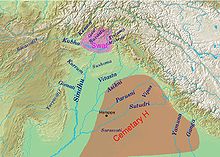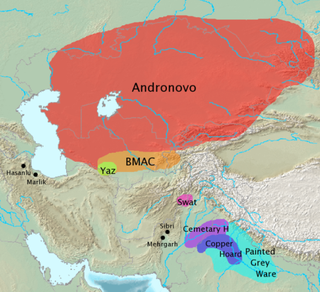Loading AI tools
Bronze Age culture in the Punjab From Wikipedia, the free encyclopedia
The Cemetery H culture was a Bronze Age culture in the Punjab region in the northern part of the Indian subcontinent, from about 1900 BCE until about 1300 BCE. It is regarded as a regional form of the late phase of the Harappan (Indus Valley) civilisation (alongside the Jhukar culture of Sindh and Rangpur culture of Gujarat), but also as a phase of the Indo-Aryan migrations[citation needed].
 The extent of the Swat and Cemetery H cultures are indicated; Geography of the Rigveda, with Rigvedic rivers names | |
| Geographical range | Pakistan North India (Punjab, Haryana, Western Uttar Pradesh) |
|---|---|
| Period | Bronze Age |
| Dates | c. 1900–1300 BCE |
| Type site | Harappa |
| Major sites | Harappa Bhagwanpura |
| Characteristics | Extensive copper metallurgy cremation of human remains |
| Followed by | Painted Grey Ware culture |


The Cemetery H culture was located in and around the Punjab region in present-day India and Pakistan. It was named after a cemetery found in "area H" at Harappa. Remains of the culture have been dated from about 1900 BCE until about 1300 BCE.
According to Mohammad Rafique Mughal, the Cemetery H culture developed out of the northern part of the Indus Valley civilization around 1700 BCE, being part of the Punjab Phase,[1] one of three cultural phases that developed in the Localization Era or "Late Harappan phase" of the Indus Valley Tradition.[2][3] According to Kenoyer, the Cemetery H culture "may only reflect a change in the focus of settlement organization from that which was the pattern of the earlier Harappan phase and not cultural discontinuity, urban decay, invading aliens, or site abandonment, all of which have been suggested in the past."[4] According to Kennedy and Mallory & Adams, the Cemetery H culture also "shows clear biological affinities" with the earlier population of Harappa.[5][6]
Some traits of the Cemetery H culture have been associated with the Swat culture, which has been regarded as evidence of the Indo-Aryan movement toward the Indian subcontinent.[7] According to Parpola, the Cemetery H culture represents a first wave of Indo-Aryan migration from as early as 1900 BCE, which was followed by a migration to the Punjab c. 1700–1400 BCE.[8] According to Kochhar, the Swat IV co-founded the Harappan Cemetery H phase in Punjab (2000–1800 BCE), while the Rigvedic Indo-Aryans of Swat V later absorbed the Cemetery H people and gave rise to the Painted Grey Ware culture (to 1400 BCE).[9]
Together with the Gandhara grave culture and the Ochre Coloured Pottery culture, the Cemetery H culture is considered by some scholars as a factor in the formation of the Vedic civilization.[9]
The distinguishing features of this culture include:[10]
Some of the designs painted on the Cemetery H funerary urns have been interpreted through the lens of Vedic mythology:
For instance, peacocks with hollow bodies and a small human form inside, which has been interpreted as the souls of the dead, and a hound that can be seen as the hound of Yama, the god of death.[12][13] This may indicate the introduction of new religious beliefs during this period, but the archaeological evidence does not support the hypothesis that the Cemetery H people were the destroyers of the Harappan cities.[14]
Cremation in India is first attested in the Cemetery H culture, a practice previously described in the Vedas. The Rigveda contains a reference to the emerging practice, in RV 10.15.14, where the forefathers "both cremated (agnidagdhá-) and uncremated (ánagnidagdha-)" are invoked.
Seamless Wikipedia browsing. On steroids.
Every time you click a link to Wikipedia, Wiktionary or Wikiquote in your browser's search results, it will show the modern Wikiwand interface.
Wikiwand extension is a five stars, simple, with minimum permission required to keep your browsing private, safe and transparent.